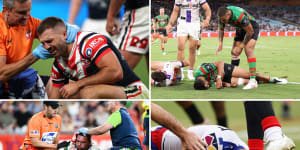Webster and FitzSimons have both suggested ways to reduce the incidence of concussions. However,such solutions are like counting angels on the head of a pin. The problem is enormous and deserves much broader consideration.

Players who suffered a concussion in the last NRL season:(Clockwise from top left) James Tedesco,Alex Johnston,Kalyn Ponga and Jordan Rapana.Getty Images
We are not anti-rugby or rugby league. One of us (Morgan) played rugby at school,as did his three sons. He watches both codes of rugby. The second author (Boyd) coached the First XV at St Joseph’s College,Hunters Hill to 11 GPS premierships. We hope both codes of rugby continue.
But concussion needs to be urgently and successfully addressed. In elite rugby union,,at least one concussion every 2½ games,is far too high.
The science is accepted by most medical experts in the field that concussion injury is a brain injury,and repeated concussion injuries can lead to irreversible brain damage that can progress and be disabling. Recovery from a brain injury differs from injuries to bone and muscle because many brain cells cannot regenerate. Once lost,they cannot be replaced. Therefore,avoiding an excessive number of concussions that lead to brain damage is imperative.
We do not have enough knowledge to know all actions required to reduce disabling brain injury complicating recurrent concussions,but we do have enough knowledge to act. The difficulty will be to introduce reasonable measures now to prevent disability from brain injuries that will not be manifested for perhaps decades. This time span makes evidence-based decisions on whatever action is taken intolerably long for many current sports participants. It is inevitable that not all actions will be perfect,and some will be wrong.
There is a lot of busy activity and changes around concussion. However,recognition alone does not avoid damage. It is important to understand that higher standards of recognition do not prevent concussion,they just make the diagnosis.
Similarly,time out of sport after injury is not avoiding damage. Except for children who have a second concussion,having not recovered from the first,there is no compelling evidence of what is the minimum time needed before it is safe to return to contact sport after a concussion. However,it seems logical to ensure that all symptoms have completely passed before returning to the field.
The more concussions that occur,the more likely there will be accumulated irreversible damage that becomes disabling or progressive. At this point,no maximum number of concussion injuries has been established before mandatory retirement should be recommended.
You will be disappointed if you think doctors can arbitrate on whether or not players can continue in the sport after repeated concussion injuries. They can detect permanent brain injury,but by this stage,it is too late.
If doctors are to make recommendations based on risks,expectations and alternatives,with the potential risk of legal obligations,their assessment may be very conservative given the current level of medical understanding. It is reasonable to expect that,in the future,there will be a metric where mandatory retirement must take place.
However,this is dependent on establishing a correct diagnosis and count of concussions,which creates a number of complex problems. Will there be the expertise at the concussion episode to correctly make the diagnosis? Will the coach,club,or school record and act on recommendations appropriately? Some organisations may find the medical and administrative burden too great and discontinue offering sports considered more dangerous.
Are the responsibilities and obligations changing,and can those responsible for their protection be found at fault? Informed consent from players at all levels must be mandated. Parents can give informed consent for their children for many things,such as school excursions and medical procedures. In the case of consenting to allow a child to play contact sport,the benefits are obscure,and there are alternative activities to gain health benefits or learn team participation.
The risks of the sport are not zero.
We make five recommendations:
- Rules should continue to change to reduce the incidence of concussions.
- Informed consent should be obtained from players. Furthermore,they must renew their consent after they have recovered from each concussion episode as the risk of permanent brain injury will have changed. Obtaining informed consent for minors is challenging. Their parents must be fully informed and kept abreast of emerging knowledge.
- A registry should be kept of concussion injuries for all players at all levels of the sport. It is insufficient for the registry to be mandated only for professional sports,as all professional players have a history that may be of importance. This registry must be audited both for its accuracy and completeness.
- A maximum number of concussions should be mandated,after which the player is permanently prevented from participating in the sport. This requires addressing what to do if players or their parents refuse to comply. Given the number of concussion injuries that are safe is not yet known,this should initially be set at a relatively high number,such as 10,and brought lower as evidence comes to hand. We suspect it could ultimately fall to as low as three.
- Quality research remains a priority. Answers will take a long time to obtain,but actions will need to occur now and be modified with the unveiling results.
Although these recommendations may seem to present insurmountable burdens,the most complex of them were adopted and introduced by St Joseph’s College,Hunters Hill,in 1998,when the school had close to 50 teams from under-12 to the first XV. Unless radical changes are made by the football codes,there will be a shrinking pool of players going on to play professional sport.
If the codes do not more urgently adapt,they will be destroyed by insurance,law,parents refusing to let their children play contact sports,and the mounting evidence of lives destroyed.
Michael Kerin Morgan is an emeritus professor at Macquarie University and a former neurosurgeon;Anthony Boyd is a Marist brother and former deputy headmaster at St Joseph’s College,Hunters Hill.